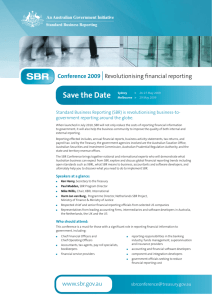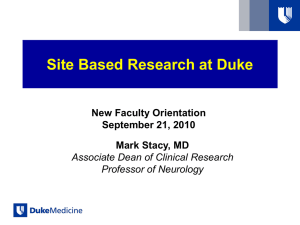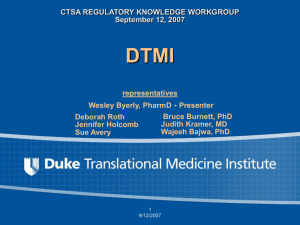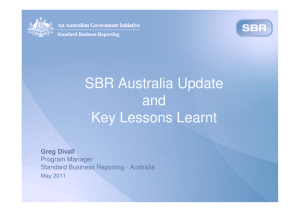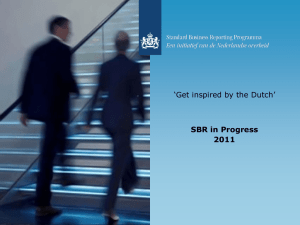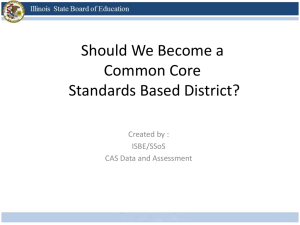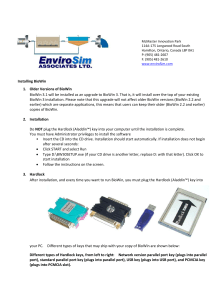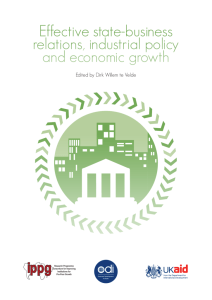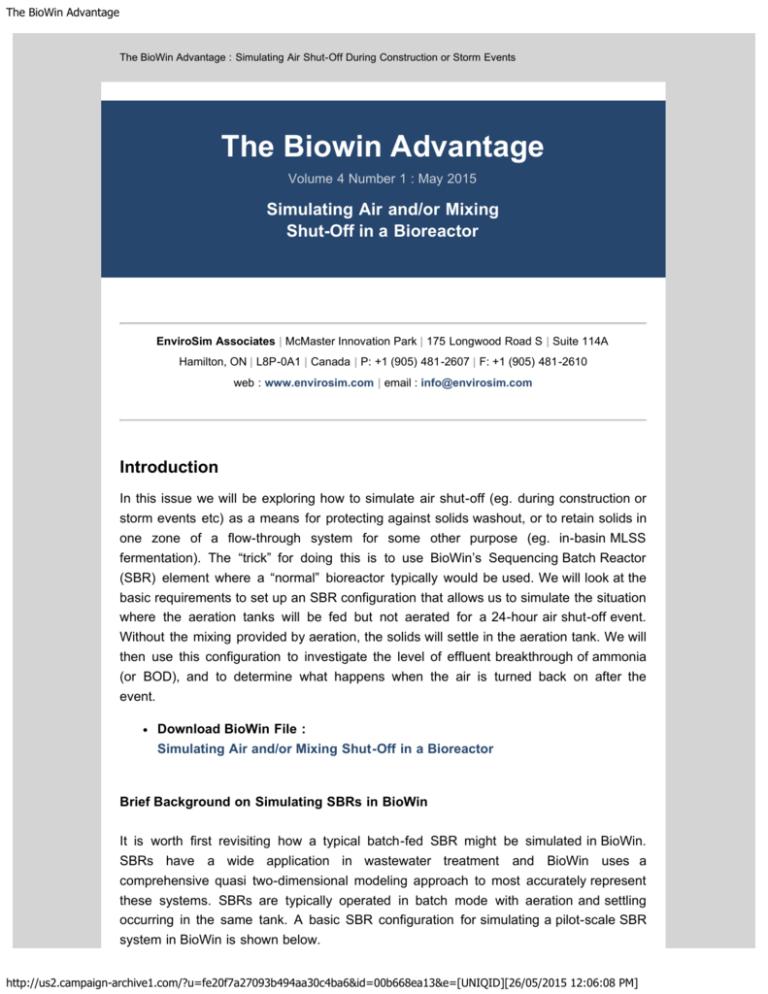
The BioWin Advantage
The BioWin Advantage : Simulating Air Shut-Off During Construction or Storm Events
The Biowin Advantage
Volume 4 Number 1 : May 2015
Simulating Air and/or Mixing
Shut-Off in a Bioreactor
EnviroSim Associates | McMaster Innovation Park | 175 Longwood Road S | Suite 114A
Hamilton, ON | L8P-0A1 | Canada | P: +1 (905) 481-2607 | F: +1 (905) 481-2610
web : www.envirosim.com | email : info@envirosim.com
Introduction
In this issue we will be exploring how to simulate air shut-off (eg. during construction or
storm events etc) as a means for protecting against solids washout, or to retain solids in
one zone of a flow-through system for some other purpose (eg. in-basin MLSS
fermentation). The “trick” for doing this is to use BioWin’s Sequencing Batch Reactor
(SBR) element where a “normal” bioreactor typically would be used. We will look at the
basic requirements to set up an SBR configuration that allows us to simulate the situation
where the aeration tanks will be fed but not aerated for a 24-hour air shut-off event.
Without the mixing provided by aeration, the solids will settle in the aeration tank. We will
then use this configuration to investigate the level of effluent breakthrough of ammonia
(or BOD), and to determine what happens when the air is turned back on after the
event. Download BioWin File :
Simulating Air and/or Mixing Shut-Off in a Bioreactor
Brief Background on Simulating SBRs in BioWin
It is worth first revisiting how a typical batch-fed SBR might be simulated in BioWin.
SBRs have a wide application in wastewater treatment and BioWin uses a
comprehensive quasi two-dimensional modeling approach to most accurately represent
these systems. SBRs are typically operated in batch mode with aeration and settling
occurring in the same tank. A basic SBR configuration for simulating a pilot-scale SBR
system in BioWin is shown below.
http://us2.campaign-archive1.com/?u=fe20f7a27093b494aa30c4ba6&id=00b668ea13&e=[UNIQID][26/05/2015 12:06:08 PM]
The BioWin Advantage
Double clicking on the Influent Element shows us that the Input Type is set to Variable.
If we click the Edit data button, BioWin’s Influent Itinerary opens and we see that during
the first 5 minutes of a 1-day cycle, an instantaneous flowrate of 2,304 m3/d enters the
SBR. This translates into a total flow of 8 m3/d (i.e. 2304 m3/d x 5 min x 1 d/1440 min x 1
cycle/d).
http://us2.campaign-archive1.com/?u=fe20f7a27093b494aa30c4ba6&id=00b668ea13&e=[UNIQID][26/05/2015 12:06:08 PM]
The BioWin Advantage
BioWin also allows SBRs to be configured to have continuous flow. In this case, feed will
even enter during settle and decant mode. Two possible ways this can be achieved is by
setting the Input Type in the influent element to Constant, or by specifying Variable
with a 24-hour flow pattern.
Double clicking on the SBR element allows us to input the cycle time and design
characteristics of the SBR. On the SBR dimensions tab we specify the size of the tank
(i.e. 10.5 m3) and the minimum decant level (i.e. 20% of full = 0.2 x 10.5 = 2.1 m3).
Based on the influent volume addition of 8 m3 the total operating volume of the SBR is
10.1 m3 (i.e. 8 + 2.1 m3). It is important to note that if the operating volume exceeds
the SBR volume, the SBR will overflow and you will have flow coming out even if
you are not decanting – possibly containing significant amounts of mixed liquor
solids!
http://us2.campaign-archive1.com/?u=fe20f7a27093b494aa30c4ba6&id=00b668ea13&e=[UNIQID][26/05/2015 12:06:08 PM]
The BioWin Advantage
On the SBR operation tab the cycle times, outflow and aeration information are input. In
this example, the cycle length is 1 day (to have multiple cycles in a day we simply
shorten the cycle length). The SBR reacts (i.e. mixes and aerates) until 23 hours and 15
minutes as specified by the Mix until/Start settling at time. This also corresponds to a
settling period of 45 minutes. The SBR starts to decant at 23 hours and 40 minutes
corresponding to a decant time of 20 minutes (note that BioWin allows solids settlement
to continue during the decant phase). You can select to either input a specific decant
flow rate, or have BioWin calculate the required flowrate to achieve the minimum decant
level during the decant phase. In this example, we have selected the latter option; so 8
m3 of liquid volume will be decanted (i.e. 10.1 – 2.1 m3). The outflow is determined
based on the time specified for the decant period (i.e. outflow = 8 m3/20 min x 1440
min/d = 576 m3/d). This flow will be displayed during the decant period when the cursor
is hovering over the outflow pipe. Clicking the SBR aeration button on the SBR
operation tab opens the SBR zone aeration dialogue box. A constant DO set point of 3
mg/L is specified. It is important to note that despite the fact that a constant DO set point
is specified, BioWin does not aerate SBRs during the specified settling period. http://us2.campaign-archive1.com/?u=fe20f7a27093b494aa30c4ba6&id=00b668ea13&e=[UNIQID][26/05/2015 12:06:08 PM]
The BioWin Advantage
The simplest way to achieve solids wasting from a BioWin SBR element is via the SBR
underflow tab. In this example, we will only have an intermittent waste flow, so the
Underflow type is set to Flow pattern. Clicking on the Pattern button opens the
http://us2.campaign-archive1.com/?u=fe20f7a27093b494aa30c4ba6&id=00b668ea13&e=[UNIQID][26/05/2015 12:06:08 PM]
The BioWin Advantage
Underflow rate itinerary. This itinerary allows you to specify when the wastage event
will occur (i.e. during react or during settle). In this example, a 10-minute wastage period
has been specified starting at 23 hours and 5 minutes and lasting until 23 hours and 15
minutes (i.e. MLSS is wasted just before settling commences). A total volume of 0.67 m3
is wasted (i.e. 96.48 m3/d x 10 min x 1 d/1440 min x 1 cycle/d). When simulating SBRs it is a good idea to plot the SBR liquid volume in the BioWin
Album to ensure there is no unintended overflow (i.e. the liquid volume remains below
the tank volume) and to verify the wastage and decant volumes and cycle times. In the
example below, we can see the volume was maintained at the expected level for most of
the day, takes a slight dip when wasting occurs, and then drops away rapidly when the
decant phase occurs.
Additional features to note about SBR simulation in BioWin is that:
http://us2.campaign-archive1.com/?u=fe20f7a27093b494aa30c4ba6&id=00b668ea13&e=[UNIQID][26/05/2015 12:06:08 PM]
The BioWin Advantage
The Width parameter on the Dimensions tab is used to calculate the horizontal
length of the SBR; flow moves along the horizontal length from the inlet to the
outlet.
The horizontal length is divided into 3 equal-length subsections.
The vertical depth of each of the three subsections is divided into 10 equal-depth
layers resulting in a total of 30 cells in the SBR.
When we plot a parameter at the outlet of an SBR in BioWin, we are plotting the
response in the top layer of the last (3 rd) subsection of the SBR length. When we plot a
parameter in the SBR underflow, we are plotting the response in the bottom layer of the
last (3 rd) subsection of the SBR length. This is especially important to remember when
looking at solid concentrations. When the SBR goes into settle mode, the solids in the
upper section of the SBR will decrease while the solids in the lower section of the SBR
will increase.
The BioWin Configuration
The BioWin configuration we will use is shown below. For this BioWin Advantage
scenario, SBR reactor elements are used in place of bioreactors. The use of SBRs
allows the air shut-off event to be modeled as a settling event (i.e. aeration and mixing is
automatically turned off when the SBR enters the settle phase). For this example, we will
set up the SBRs quite different to the “standard” method discussed in the Background
section above. That is, we will set up the SBRs such that they will be allowed to overflow
since we are using them to simulate a flow-through reactor. Some other important
aspects of this configuration include:
The SBRs are operated with continuous flow (i.e. with a 24 hour flow pattern
specified in the influent element)
The decant flow rate and decant period in the SBRs is set to allow the
maintenance of a near-constant tank volume as shown on the SBR Operation tab
below (i.e. a decant flow rate of 1 m3/d and decant period of 1 minute).
http://us2.campaign-archive1.com/?u=fe20f7a27093b494aa30c4ba6&id=00b668ea13&e=[UNIQID][26/05/2015 12:06:08 PM]
The BioWin Advantage
The underflow rate in the SBRs is set to zero to ensure no wasting and the
maintenance of a constant volume. BioWin requires a pipe connection to the
underflow, so the underflow is connected to an output element labelled “Not Used”.
The overall cycle time in the SBRs is set to one month (i.e. 30 days) with settling
(i.e. the air shut-off event) only happening on day 29 as shown on the SBR
Operation tab. This allows us to run a dynamic simulation under “normal” flowthrough conditions for an extended period to establish a steady state prior to the
air shut-off event. [Recall that the steady state solver is not available for SBRs in
BioWin.]
Setting up the BioWin Album to Track Composite Sample Concentrations
http://us2.campaign-archive1.com/?u=fe20f7a27093b494aa30c4ba6&id=00b668ea13&e=[UNIQID][26/05/2015 12:06:08 PM]
The BioWin Advantage
Breakthrough of BOD or ammonia may result in effluent concentrations that exceed
compliance limits. Effluent limits are often based on composite samples. In the BioWin
file the effluent ammonia concentrations are summarized on the first tab of the BioWin
Album in terms of an instantaneous concentration, a flow weighted daily composite
concentration, and a flow weighted monthly composite.
The following steps summarize how to plot daily composite concentrations:
1.
2.
3.
4.
Open the BioWin Album (Ctrl+A)
Add a new page to the Album (Ctrl+A)
Add a chart (right-click and choose the ‘chart’ option)
On the Time series tab:
a. From the State variables group select Ammonia N.
b. From the Elements group select Effluent to expand the list and choose
Effluent.
c. From the Plot Type choose Composite samples to display Composite
sample options.
d. From Composite sample options select a composite period of 1 day (i.e. a
daily composite) and check the flow weighted sample box.
e. Click Plot selected… and choose the Point series type.
f. Click close to exit the dialogue box.
Note that monthly composites are calculated by choosing a 30-day composite period.
http://us2.campaign-archive1.com/?u=fe20f7a27093b494aa30c4ba6&id=00b668ea13&e=[UNIQID][26/05/2015 12:06:08 PM]
The BioWin Advantage
Dynamic Simulation
The BioWin file that accompanies this edition of the BioWin Advantage was simulated
using the following steps:
1. To establish a steady state condition prior to the shut down event a dynamic
simulation was run for 25 days starting from seed values. The establishment of
steady state in a 25-day period was specific to this example. It may be necessary
to run multiple 25-day runs (i.e. the first 25 day run starting from seed values, and
subsequent 25 day runs starting from current values) to establish steady state in
other examples with different operating parameters.
2. To simulate ‘turning the air off’ a second dynamic simulation was run for 35 days
starting from current values. During this simulation, the system runs along for 29
days in “normal mode”, and then on the 29th day “air goes off” and the solids in
the SBRs settle to the bottom of the reactor.
Results and Discussion
http://us2.campaign-archive1.com/?u=fe20f7a27093b494aa30c4ba6&id=00b668ea13&e=[UNIQID][26/05/2015 12:06:08 PM]
The BioWin Advantage
The BioWin Album contains many charts that are useful for interpreting the response of
the system.
First, let’s look at the third tab of the Album which shows the MLSS concentration in
each SBR. The MLSS concentration in the upper level of the SBRs declines when the
SBRs go into settle mode on day 29. The Album tab also shows the MLSS concentration
increasing in the lower level of the SBR as the solids accumulate in the lower level during
settling.
Next let’s look at the effluent ammonia and nitrate concentrations (1 st tab). The charts
show that the removal of ammonia and production of nitrate is stable for the first 28
days. On day 29 however, we see breakthrough of ammonia (i.e. the instantaneous
ammonia concentration spikes above 25 mg/L) and the simultaneous reduction in nitrate
in line with the “shut-down” event. Then on day 30 (and for the following several days)
the SBRs return to fully mixed mode and the system comes back to normal. Based on
the ammonia daily composite concentrations (orange squares), the system takes 2 days
to return to ‘normal’. The BOD concentrations (summarized in the second tab of the
album) follow a similar trend to that of the effluent ammonia. It is interesting to note that
in spite of the very high instantaneous and composite ammonia concentrations
http://us2.campaign-archive1.com/?u=fe20f7a27093b494aa30c4ba6&id=00b668ea13&e=[UNIQID][26/05/2015 12:06:08 PM]
The BioWin Advantage
associated with the air shut-off event, the monthly composite value does not get too high
due to the very low concentrations achieved throughout the first period of the month.
Finally, let’s take a look at the ammonia oxidizing bacteria (AOB) and nitrite oxidizing
bacteria (NOB). The AOBs and NOBs settle out during the event but return to their
‘normal’ concentrations shortly after the event as shown by continuing the dynamic
simulation for an additional 5 days.
Additional Simulation Scenarios
http://us2.campaign-archive1.com/?u=fe20f7a27093b494aa30c4ba6&id=00b668ea13&e=[UNIQID][26/05/2015 12:06:08 PM]
The BioWin Advantage
This configuration can also be used to simulate the following additional scenarios:
A longer shut down period (i.e. 48 hours). This is achieved by adjusting the Mix
until/Start settle at time period to 28 days on the SBR operation tab. This results
in 3 days of high effluent ammonia concentrations and increases the monthly
composite ammonia concentration from 0.6 to 1.6 mg/L as shown below.
Air shut down in only one aeration basin (i.e. zone 1). This is achieved by
adjusting the Mix until/Start settle at time period in the SBR operation tab of the
other SBR elements (i.e. zone 2 & 3) such that they go into settle one minute
before decant (that is, these zones are essentially fully-mixed all the time). The
chart below shows the ripple effect this has on the ammonia concentrations in the
aeration tank.
Turning down the settleability of the solids in the SBR zones. This adjustment
could be made to account for the time required to dissipate mixing energy,
http://us2.campaign-archive1.com/?u=fe20f7a27093b494aa30c4ba6&id=00b668ea13&e=[UNIQID][26/05/2015 12:06:08 PM]
The BioWin Advantage
resulting in some degree of MLSS washout from the bioreactors to the clarifier
during the air shut-off event. As shown in the chart below, the MLSS concentration
does not go to zero in the upper level of the aeration tank as before; that is, for
most of the event duration, solids are flowing out of the aeration tank at between
500 and 1,000 mg/L instead of being fully retained as before.
Simulation of this scenario is achieved by:
Using local settling parameters in the secondary clarifier (FST).
Double click on the clarifier element, Select the Settling model tab, Check
the Local settling parameters box
http://us2.campaign-archive1.com/?u=fe20f7a27093b494aa30c4ba6&id=00b668ea13&e=[UNIQID][26/05/2015 12:06:08 PM]
The BioWin Advantage
Using global settling parameters to penalize settling in the SBRs
Select the menu option Project > Parameters > Settling
Select the Modified Vesilind tab and modify the maximum Vesilind settling
velocity (Vo) and the Vesilind hindered zone settling parameter (K)
http://us2.campaign-archive1.com/?u=fe20f7a27093b494aa30c4ba6&id=00b668ea13&e=[UNIQID][26/05/2015 12:06:08 PM]
The BioWin Advantage
Conclusion
In this edition of the BioWin Advantage, we used SBRs to simulate the loss of air and
mixing in a bioreactor. We also learned how to show composite concentrations while
charting the system response. In future editions, we will look at more complex shut down
applications, and also continue to explore other features of BioWin.
We trust that you found this technical topic both interesting and informative.Please feel
free to contact us at support@envirosim.com (Subject: The BioWin Advantage) with your
comments on this article or suggestions for future articles.
Thank you, and good modeling.
The EnviroSim Team
NEWS FROM ENVIROSIM
Click here to find out the latest EnviroSim News...conferences, training, and more!
BIOWIN TRAINING COURSES
EnviroSim offers training courses on our entire software suite, as well as software independent courses covering
general aspects of modeling, model calibration and wastewater processing.
BIOWIN PAPERS
Looking for the title of that BioWin presentation you attended at a recent conference? We list them all here.
Copyright © 2015 EnviroSim Associates Ltd, All rights reserved.
unsubscribe | update subscription preferences | forward to a colleague http://us2.campaign-archive1.com/?u=fe20f7a27093b494aa30c4ba6&id=00b668ea13&e=[UNIQID][26/05/2015 12:06:08 PM]

